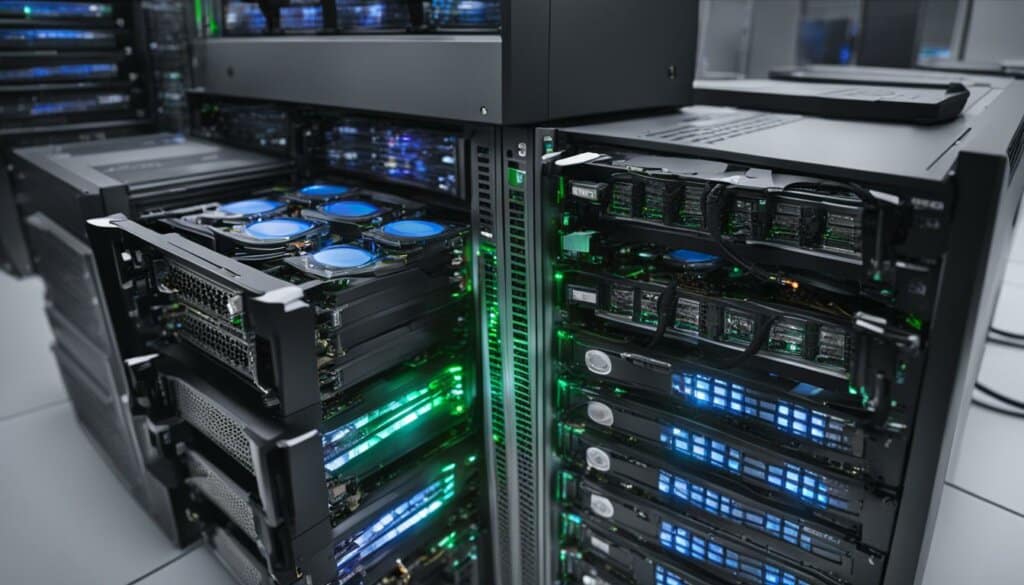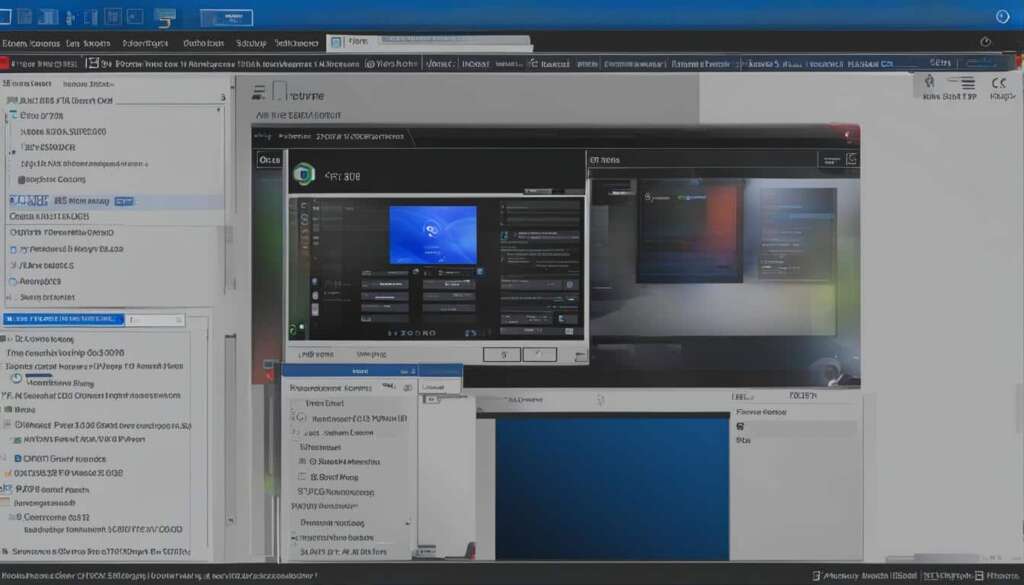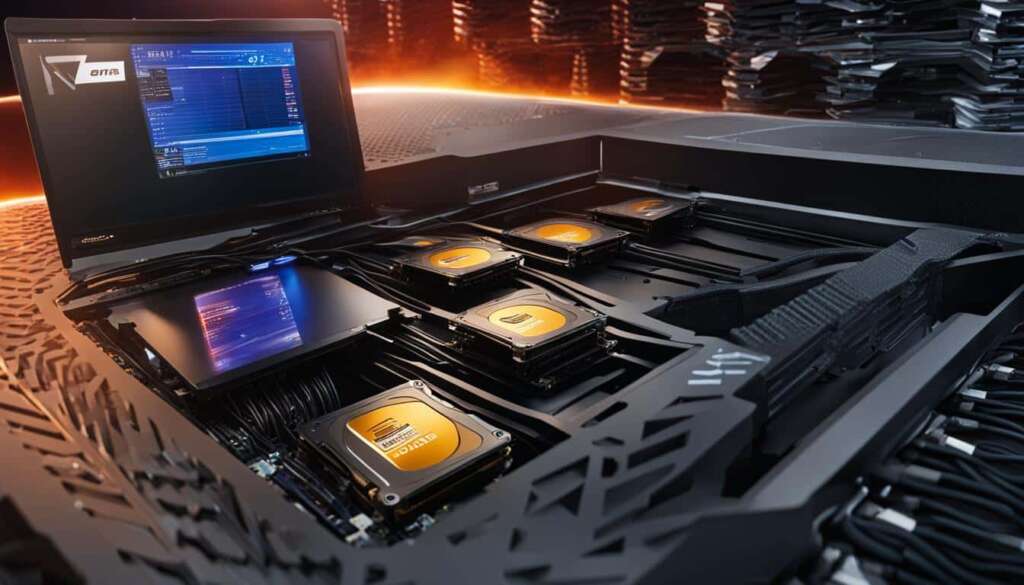Table of Contents
RAID (Redundant Array of Inexpensive Disks) technology is a game-changer for PC servers. By combining multiple disk drives into a single logical unit, RAID brings faster performance, enhanced hardware failover, and improved disk I/O reliability. With RAID configurations, your PC server can reach new heights of data safety and server performance.
Implementing RAID in your PC server provides a myriad of benefits, including protection against hard drive failures, reduced downtime, and improved data reliability. Whether you’re a small business owner, an IT professional, or a gaming enthusiast, RAID can revolutionize your server experience.
In this article, we’ll delve into the world of RAID technology, exploring RAID levels, configuration options, and troubleshooting. Discover the power of RAID and unlock the true potential of your PC server.
Does Your Server Need RAID?
When it comes to server management, uptime is crucial. Any downtime can result in lost productivity, missed opportunities, and unhappy customers. That’s why it’s essential to consider implementing RAID (Redundant Array of Inexpensive Disks) in your server setup. RAID provides a failover insurance that ensures your server remains operational even in the face of hard drive failures.
Without RAID, a single hard drive failure can bring your server to a halt while the failed drive is replaced and reconfigured. This downtime can be costly and disruptive to your business operations. With RAID, however, the failed drive can be swapped out, and the RAID can be rebuilt seamlessly without the need for backup restoration. This means that your server can continue running smoothly without any significant interruption, minimizing the impact of hardware failures on your server’s uptime.
RAID not only offers failover insurance but also provides data protection. By distributing data across multiple drives, RAID safeguards your data against loss in the event of drive failures. This redundancy ensures that your valuable data remains intact and accessible. So, if uptime is important to your operations and you value data protection, implementing RAID in your server is a wise choice.
Benefits of RAID for Data Protection
| Benefits | Description |
|---|---|
| Fault Tolerance | RAID provides redundancy, allowing your server to continue running even if a drive fails. |
| Data Integrity | RAID safeguards your data against loss or corruption, ensuring its integrity is maintained. |
| Minimized Downtime | With RAID, drive failures can be resolved quickly and without significant downtime. |
| Improved Reliability | RAID configurations increase the overall reliability of your server, reducing the risk of data loss and system failures. |
By implementing RAID in your server, you can ensure that your data is protected, your server remains operational, and your business can thrive without the fear of unexpected hardware failures causing significant disruptions.
Hardware vs Software RAID
When implementing a RAID configuration in your PC server, one of the key decisions you’ll need to make is whether to use hardware RAID or software RAID. Each option has its own advantages and considerations, ensuring that you choose the right solution for your needs.
Hardware RAID: With hardware RAID, you connect the drives to a RAID controller card that is inserted into your server’s motherboard. This dedicated RAID controller handles all the processing for the RAID configuration, resulting in optimal performance. Hardware RAID offers greater flexibility and configuration options, allowing you to choose from a wider range of RAID levels.
Software RAID: On the other hand, software RAID relies on the operating system of your server to manage the RAID configuration. This means that you don’t need any additional hardware, as the RAID functionality is built into the software. Software RAID is generally more cost-effective since it doesn’t require a separate RAID controller. However, it is limited to the RAID levels supported by the operating system.
When deciding between hardware and software RAID, consider factors such as the performance impact, cost, and your specific requirements. Hardware RAID offers better performance, especially for larger scale configurations, but it can be more expensive. Software RAID is a budget-friendly option that is easy to set up but may have limitations depending on your operating system’s capabilities.
RAID Configuration Options
Whichever option you choose, both hardware and software RAID provide a variety of configuration options to meet your needs. The most common RAID levels include:
- RAID 0: Provides improved read and write performance but lacks fault tolerance.
- RAID 1: Offers data redundancy by mirroring data across multiple drives.
- RAID 5: Combines data striping and distributed parity for improved performance and fault tolerance.
- RAID 10: A nested array that combines mirroring and striping to provide both performance and fault tolerance.
Choosing the right RAID level depends on your priorities, such as the level of redundancy you need, performance requirements, and available disk space. It’s important to carefully evaluate your server’s needs and consult with experts if necessary to determine the best RAID configuration for your specific use case.
| RAID Level | Redundancy | Performance | Disk Space Efficiency |
|---|---|---|---|
| RAID 0 | No | High | 100% |
| RAID 1 | High | Medium | 50% |
| RAID 5 | High | Medium | 67% |
| RAID 10 | High | High | 50% |
Choosing the Best RAID Configuration
When it comes to implementing RAID configurations in your PC server, choosing the right RAID configuration is crucial to meet your specific needs and priorities. There are several RAID levels to choose from, each with its own pros and cons. Understanding these configurations will help you make an informed decision.
RAID Levels Overview
RAID 0, also known as striping, offers improved read and write performance by spreading data across multiple drives. However, it does not provide fault tolerance, so a single drive failure can result in data loss.
RAID 1, or mirroring, provides data redundancy by duplicating data across multiple drives. While it offers excellent fault tolerance, it reduces available capacity as each drive is a mirror of the other.
RAID 5 combines data striping and distributed parity across multiple drives. This configuration provides both performance and fault tolerance, as it can tolerate the failure of a single drive without data loss. However, it requires a minimum of three drives.
RAID 10, also known as nested RAID, combines mirroring and striping. It offers both performance and fault tolerance by creating multiple mirrored pairs of drives and then striping data across them. RAID 10 requires a minimum of four drives.
Considerations for RAID Configuration
When choosing a RAID configuration, consider factors such as redundancy, performance, and disk size. RAID 1 and RAID 10 provide better fault tolerance and redundancy, while RAID 0 offers improved performance. RAID 5 offers a balance between performance and fault tolerance, making it a popular choice for many server applications.
Additionally, consider the size of your disks and the number of drives you have available. Some RAID configurations require a minimum number of drives, so ensure you have enough to support your chosen configuration.
Remember that each RAID configuration has its own advantages and disadvantages. It’s important to weigh these factors against your specific requirements to determine the best RAID configuration for your PC server.
| RAID Level | Redundancy | Performance | Disk Size |
|---|---|---|---|
| RAID 0 | No redundancy | Improved performance | Utilizes full disk size |
| RAID 1 | Data redundancy | Reduced performance | 50% of total disk size |
| RAID 5 | Data redundancy | Good performance | Utilizes full disk size (minus parity) |
| RAID 10 | Data redundancy | Excellent performance | 50% of total disk size (mirrored pairs) |
The Importance of BBU in RAID
In the world of RAID configurations, ensuring data integrity and protection is paramount. One crucial component that plays a vital role in this is the BBU, or battery backup unit. The BBU acts as a fail-safe mechanism, preserving data integrity and providing a safety net against potential data loss in case of server power loss.
Without a BBU, a sudden power loss can result in corrupted data and damage to your RAID configuration. The BBU serves as a data fail safe, safeguarding the cached data on your server’s RAID card. By connecting to the RAID controller, the BBU ensures that even in the event of a power outage, your data remains intact.
Having a BBU for your RAID card offers peace of mind, knowing that your data is protected. It acts as a backup power source, allowing the RAID controller to save any cached data to disk before the power is completely lost. This extra layer of protection is essential for maintaining data integrity and minimizing the risks associated with unexpected power interruptions.
| Benefits of BBU in RAID |
|---|
| Data Integrity: The BBU safeguards cached data, ensuring its integrity and preventing data corruption. |
| Data Fail Safe: In case of server power loss, the BBU acts as a fail-safe mechanism, protecting your data from potential loss or damage. |
| RAID Card Protection: The BBU connects directly to the RAID controller, providing an additional layer of protection for your RAID configuration. |
| Power Outage Resilience: By serving as a backup power source, the BBU allows the RAID controller to save cached data to disk before complete power loss, minimizing the risk of data loss. |
Utilizing a RAID Calculator
When configuring a RAID setup for your PC server, it’s crucial to choose the right RAID configuration that suits your needs. To optimize your server’s performance and ensure the best configuration, you can make use of a RAID calculator. A RAID calculator is a valuable tool that helps you compare different RAID options and drive sizes, taking into account factors such as server performance, disk input/output performance, and fault tolerance.
By inputting the number of drives and their capacities, the RAID calculator provides detailed information on each RAID level’s description, minimum number of disks required, disk performance, and fault tolerance. This allows you to make an informed decision and select the ideal RAID configuration that strikes a balance between performance, capacity, and fault tolerance.
| RAID Level | Description | Minimum Number of Disks | Disk Performance | Fault Tolerance |
|---|---|---|---|---|
| RAID 0 | Improved performance, no fault tolerance | 2 | High | None |
| RAID 1 | Data redundancy, reduced capacity | 2 | Medium | High |
| RAID 5 | Data striping, distributed parity | 3 | High | Medium |
| RAID 10 | Combination of performance and fault tolerance | 4 | High | High |
With the help of a RAID calculator, you can easily visualize the different RAID options and their corresponding benefits. This ensures that you configure your RAID setup based on your specific requirements, allowing for optimal server performance and data protection. So take advantage of a RAID calculator and make an informed decision when implementing RAID in your PC server.

Setting Up RAID in Windows
Windows operating systems, starting from Windows XP, offer built-in RAID functionality known as Windows software RAID. This feature allows users to create and manage RAID configurations without the need for additional hardware. The specific RAID types and functionalities available depend on the Windows version. Windows software RAID is flexible and easy to configure, allowing users to create arrays from within the Windows Drive Manager. It supports various RAID levels, including RAID 0, 1, and 5, and offers advantages such as the ability to mirror individual partitions and delete one half of a mirror without affecting the other.

Configuring RAID in Windows is a straightforward process. Here’s a step-by-step guide to get you started:
Step 1: Open Disk Management
To begin, open the Disk Management utility in Windows. You can access it by right-clicking on the Start button and selecting “Disk Management” from the menu. Alternatively, you can press the Windows key + X and choose “Disk Management” from the list.
Step 2: Initialize and Format the Drives
Before configuring RAID, ensure that all the drives you want to use are properly initialized and formatted. Right-click on each drive and select “Initialize Disk”. Choose the disk’s partition style (MBR or GPT) and click “OK”. Next, right-click on the unallocated space of each drive and select “New Simple Volume”. Follow the on-screen instructions to format the drives with a file system of your choice.
Step 3: Create the RAID Array
Once the drives are ready, right-click on one of the unallocated spaces and select “New Spanned Volume” or “New Striped Volume” (depending on the RAID level you want to create). Follow the prompts to select the desired drives, specify the volume size, assign a drive letter, and format the volume. Windows will then create the RAID array using the selected drives.
| RAID Level | Description | Minimum Number of Drives | Benefits |
|---|---|---|---|
| RAID 0 | Striping | 2 | Improved performance |
| RAID 1 | Mirroring | 2 | Data redundancy |
| RAID 5 | Striping with parity | 3 | Improved performance and fault tolerance |
With Windows software RAID, you have the flexibility to expand or modify the RAID array as your needs change. You can add or remove drives, migrate between different RAID levels, and even recover from certain types of failures. This built-in functionality provides a cost-effective solution for implementing RAID configurations in Windows-based systems, ensuring data protection and enhanced storage performance.
Configuring RAID 5 in Windows 10
When it comes to setting up a RAID 5 configuration in Windows 10, there are several steps involved. One of the key features of RAID 5 is its ability to provide both enhanced data protection and improved performance. To configure RAID 5 in Windows 10, follow the steps below:
- Open the Windows Settings menu and navigate to the Storage tab.
- Within the Storage tab, click on the “Manage storage spaces” option.
- Next, select the drives that you want to use for your RAID 5 array and click on the “Create a new pool and storage space” button.
- In the “Create a storage space” window, choose the drives you want to add to the pool and click on the “Create pool” button.
- Give your storage space a name and specify the size you want to allocate for it.
- Under the “Resiliency type” option, select “Parity” to enable data striping and parity for your RAID 5 array.
- Click on the “Create storage space” button to finalize the configuration.
By following these steps, you can successfully configure RAID 5 in Windows 10 and take advantage of the benefits it offers, such as drive pooling, data striping, and parity. RAID 5 provides resiliency by distributing data across multiple drives, allowing for fault tolerance in case of drive failures. It offers a balance between storage efficiency and data protection, making it a popular choice for many users.

| Step | Description |
|---|---|
| 1 | Open the Windows Settings menu and navigate to the Storage tab. |
| 2 | Click on the “Manage storage spaces” option. |
| 3 | Select the drives you want to use for your RAID 5 array. |
| 4 | Click on the “Create a new pool and storage space” button. |
| 5 | Give your storage space a name and specify the size. |
| 6 | Select “Parity” under the “Resiliency type” option. |
| 7 | Click on the “Create storage space” button to finalize the configuration. |
Summary
Configuring RAID 5 in Windows 10 involves creating a pool of drives and enabling data striping and parity. This configuration provides both enhanced storage efficiency and data protection, making it suitable for many users. By following the step-by-step instructions outlined above, you can successfully set up RAID 5 in Windows 10 and take advantage of its benefits.
Setting Up RAID 10 in Windows
RAID 10, also known as nested RAID or RAID 1+0, offers a powerful combination of mirroring and striping to provide both redundancy and performance in your PC server. Setting up RAID 10 in Windows 10 involves creating multiple pairs of mirrored drives and then tying them together to form a resilient array.
To begin the configuration process, you will need a minimum of four drives. Start by creating two separate drive pools, each consisting of a pair of drives. These pairs will serve as the foundation for the RAID 10 setup. Next, set up a two-way mirror for each drive pair, ensuring that the data is mirrored across both drives for redundancy.
Once you have created the mirrored drive pairs, you can combine them into a RAID 10 array by creating a new striped volume using the Windows Disk Management system. By implementing this nested RAID configuration, you can take advantage of both the performance benefits of striping and the data redundancy provided by mirroring.
Benefits of RAID 10 Configuration
- Improved performance: RAID 10 offers enhanced read and write speeds due to the simultaneous data striping across multiple drives.
- Redundancy: With RAID 10, your data is mirrored across multiple drives, providing a high level of fault tolerance. If one drive fails, its mirrored counterpart can seamlessly take over.
- Enhanced data protection: The combination of mirroring and striping in RAID 10 ensures that your data is safe and accessible even in the event of a drive failure.
By setting up RAID 10 in Windows, you can create a robust and reliable storage solution for your PC server. This configuration is particularly well-suited for users who prioritize both performance and data redundancy, making it an ideal choice for businesses and individuals who require high-speed access to critical data while ensuring its safety and integrity.
| RAID Configuration | Redundancy | Performance |
|---|---|---|
| RAID 10 | High | High |
| RAID 5 | High | Moderate |
| RAID 0 | None | High |
RAID 10 offers the best of both worlds – the speed of striping and the redundancy of mirroring. By setting up RAID 10 in Windows, you can ensure that your critical data is both protected and readily accessible. With this configuration, your PC server can handle intensive workloads while maintaining the integrity of your valuable information.
Understanding Other RAID Configurations
Aside from RAID 5 and RAID 10, there are several other RAID configurations available that offer unique features and benefits. Let’s take a closer look at RAID 0, RAID 1, RAID 3, RAID 4, and RAID 6.
RAID 0
RAID 0, also known as striping, combines multiple drives to improve performance. This configuration splits data across the drives, allowing for simultaneous read and write operations. However, RAID 0 does not provide redundancy, meaning if one drive fails, data loss will occur. RAID 0 is ideal for applications that require high-speed data transfer and can tolerate the risk of potential data loss.
RAID 1
RAID 1, or mirroring, involves creating an exact copy of data across multiple drives. This provides redundancy, as data is fully duplicated. In the event of a drive failure, the mirrored drive takes over seamlessly, ensuring data availability. RAID 1 offers improved data reliability but comes at the cost of reduced storage capacity, as half of the drives are used for mirroring.
RAID 3 and RAID 4
RAID 3 and RAID 4 configurations use dedicated parity drives to provide fault tolerance. RAID 3 stripes data across multiple drives, while a separate dedicated drive stores parity information for redundancy. RAID 4 operates similarly but uses block-level striping instead. Both configurations offer increased fault tolerance and the ability to recover from a single drive failure.
RAID 6
RAID 6 is designed to provide high levels of fault tolerance. It uses double parity, which means it can withstand the failure of up to two drives without losing data. RAID 6 is recommended for applications that require maximum data protection and fault tolerance. However, it comes with a trade-off, as the additional parity calculation can impact write performance.
Each RAID configuration has its own advantages and considerations. By understanding the characteristics of each RAID type, you can choose the most suitable configuration based on your specific needs and priorities.
| RAID Type | Configuration | Redundancy | Performance | Storage Efficiency |
|---|---|---|---|---|
| RAID 0 | Striping | No | High | High |
| RAID 1 | Mirroring | Yes | Medium | Low |
| RAID 3 | Striping with dedicated parity drive | Yes | Medium | High |
| RAID 4 | Block-level striping with dedicated parity drive | Yes | Medium | High |
| RAID 6 | Double parity | Yes | Medium | Medium |
Considerations and Best Practices for RAID Implementations
Implementing RAID configurations in your PC server requires careful consideration and adherence to best practices. By following these guidelines, you can ensure a successful RAID implementation that maximizes data protection, performance, and reliability.
Hardware Compatibility:
Before setting up RAID, ensure that your server motherboard supports RAID or has a compatible RAID controller. This hardware compatibility is essential for creating and managing RAID configurations effectively. Without the necessary hardware, RAID implementation may not be possible or may result in suboptimal performance.
Data Backup:
While RAID provides a level of data redundancy, it is crucial to have additional backup measures in place. RAID protects against drive failures but does not safeguard against other types of data loss, such as accidental deletions or software malfunctions. Regularly backing up your important data to external storage ensures an extra layer of protection.
Monitoring and Maintenance:
Active monitoring and regular maintenance are essential for optimal RAID performance. Utilize monitoring tools to keep track of drive health, disk input/output performance, and any potential issues. Implement a proactive maintenance schedule that includes regular checks, firmware updates, and preventive measures to prevent data loss and ensure the longevity of your RAID setup.
Implementing RAID:
When implementing RAID, follow the manufacturer’s instructions and recommended guidelines for your specific RAID configuration. Take the time to plan and understand the implications of different RAID levels and their suitability for your needs. Consider factors such as data redundancy, performance requirements, and available disk space to choose the most appropriate RAID configuration for your server.
| Considerations | Best Practices |
|---|---|
| Ensure hardware compatibility | Regularly backup important data |
| Monitor drive health and performance | Follow manufacturer’s instructions |
| Plan and choose the right RAID configuration | Implement proactive maintenance |
By considering these factors and following best practices, you can implement RAID effectively in your PC server. RAID configurations provide enhanced data protection, improved server performance, and increased fault tolerance. With the right approach, RAID can be a valuable addition to your server infrastructure, ensuring the safety and reliability of your critical data.
In addition to these considerations, it is recommended to consult with IT professionals or RAID experts to ensure a successful implementation. Their expertise and knowledge can help you navigate any challenges and ensure a smooth transition to RAID technology.
Conclusion
Implementing RAID configurations in your PC server brings a host of benefits to your data storage system. RAID technology not only enhances data safety but also boosts server performance and increases fault tolerance. By carefully selecting the right RAID configuration and ensuring proper setup and maintenance, you can safeguard your valuable data, minimize downtime, and optimize your server’s overall performance.
One of the key advantages of RAID is its ability to protect against hard drive failures. With RAID, you can create a redundant array of drives that work together to ensure uninterrupted data access even if one drive fails. This not only reduces data loss but also eliminates the need for time-consuming backup restorations. RAID also enhances server uptime by providing failover insurance, minimizing the impact of hardware failures on your operations.
RAID technology offers a reliable and efficient solution for PC server data storage. With a wide range of RAID levels to choose from, including RAID 0, RAID 1, RAID 5, and RAID 10, you can tailor your configuration to meet your specific needs. Each RAID level has its own set of advantages and disadvantages, so it’s essential to consider factors such as redundancy, performance, and disk size when making your selection.
In conclusion, RAID implementation can revolutionize your PC server’s storage capabilities. By harnessing the power of RAID, you can enjoy improved data safety, enhanced server performance, and increased fault tolerance. So, take the leap and explore the world of RAID technologies to unlock the full potential of your system.
FAQ
Does my server need RAID?
RAID is essential for PC servers to ensure optimal data safety, increase server performance, and improve disk Input/Output reliability. If uptime is critical for your operations, RAID can serve as failover insurance, protecting against hard drive failures and reducing downtime.
What is the difference between hardware RAID and software RAID?
Hardware RAID involves connecting drives to a RAID controller card for optimal performance, while software RAID uses the server’s operating system to manage the RAID configuration. Hardware RAID offers more flexibility and configuration options, but may come with a higher cost and performance impact compared to software RAID.
Which RAID configuration is best for my server?
There are several RAID levels to choose from, including RAID 0, RAID 1, RAID 5, and RAID 10. Each RAID configuration has its own pros and cons, and the best choice depends on your specific needs and priorities.
Why is a BBU important for RAID?
A BBU (battery backup unit) is crucial for RAID setups as it protects the cached data on your server’s RAID card in case of a power loss. It acts as a fail-safe mechanism, preserving data integrity and ensuring that your RAID configuration remains intact.
How can I optimize my server’s performance with RAID?
You can use a RAID calculator to compare and configure various RAID options and drive sizes to determine the best configuration for your needs. This tool helps you balance performance, capacity, and fault tolerance.
How do I configure RAID in Windows?
Windows operating systems offer built-in RAID functionality known as Windows software RAID. Users can create and manage RAID configurations without additional hardware. The specific RAID types and functionalities available depend on the Windows version.
How do I configure RAID 5 in Windows?
In Windows 10, you can create a RAID 5 array by creating a drive pool and storage space. The configuration requires a minimum of three drives and provides improved storage efficiency and data protection.
How do I set up RAID 10 in Windows?
RAID 10 involves creating multiple mirrored pairs of drives and then tying them together. This setup combines striping and mirroring for redundancy and performance. The process requires a minimum of four drives and is ideal for users who prioritize performance and data redundancy.
What are the other RAID configurations available?
In addition to RAID 5 and RAID 10, there are other RAID configurations such as RAID 0, RAID 1, RAID 3, RAID 4, and RAID 6. Each RAID type has its own unique characteristics and suitability for specific use cases.
What considerations and best practices should I follow for RAID implementations?
Some considerations and best practices include ensuring hardware compatibility, having proper data backup, monitoring and regular maintenance, and following best practices to maximize data protection, performance, and reliability.
What are the benefits of implementing RAID configurations in PC servers?
RAID configurations provide improved data safety, increased server performance, and enhanced fault tolerance. By choosing the right RAID configuration and ensuring proper setup and maintenance, you can safeguard important data, minimize downtime, and optimize your server’s overall performance.













